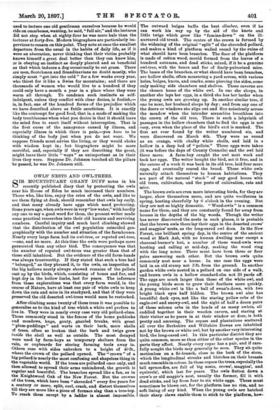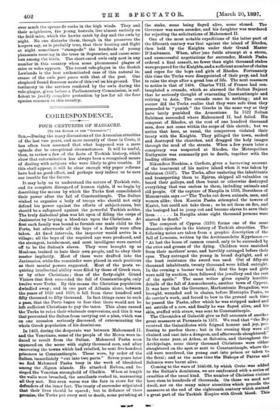OWLS' NESTS AND OWL-TREES.
SIR MOUNTSTUART GRANT DUFF notes in his recently published diary that by protecting the owls near his House of Eden he much increased their numbers. Those who, like him, enjoy the cries of the owls, and like to see them flying at dusk, should remember that owls lay early, and that many already have eggs which need protecting. Some years ago, when owls were in very "low water," with hardly any one to say a good word for them, the present writer made some practical researches into their old haunts and surviving numbers. Careful inquiry and much hard climbing showed that the distribution of the owl population coincided geo- graphically with the number and situation of the farmhouses. Nearly every large farm had its owl-tree, or reputed owl-tree, —one, and no more. At this time the owls were perhaps more persecuted than any other bird. The consequence was that the number of reputed owl-trees was greater than that of those still inhabited. But the evidence of the old farm-hands was always trustworthy. If they stated that such a tree had " belonged," as they phrased it, to the owls, an inspection of the big hollows nearly always showed remains of the pellets cast up by the birds, which, consisting of bones and fur, and kept dry in the hollow limbs, last for years. The inference from these explorations was that every farm would, in the course of Nature, have at least one pair of white owls to keep down the rats and mice in its stockyard, and that if they were preserved the old deserted owl-trees would soon be restocked.
After climbing some twenty of these trees it was possible to generalise as to the kind of tree which a white owl prefers to live in. They were in nearly every case very old pollard-elms. These commonly stood in the fences of the home paddocks and meadows, huge, gouty, gnarled trunks, with great " plum-puddings " and warts on their bark, mere shells of trees, often so broken that the bark and twigs grew inside the shell as well as outside. The most decayed were used by farm-boys as temporary shelters from the rain, or cupboards for storing farming tools away in. Others •rose with sides unbroken to a height of 40 ft., where the crown of the pollard opened. The " crown " of a big •pollard is nearly the most confusing and shapeless thing in the vegetable world. If the trees are pollarded once only, and then allowed to spread their arms unhindered, the growth is regular and beautiful. The branches spread like a fan, as in the Knightwood Oak of the New Forest. But the crowns of the trees, which have been " shrouded " every five years for a century or more, split, curl, crack, and distort themselves till they are more like a piece of furnace slag than a tree-top. To reach them except by a ladder is almost impossible. The outward bulges baffle the best climber, even if he can work his way up by the aid of the knots and little twigs which grow like " famine-down " on the ill- nurtured old trunk. The centre of the crown is formed by the widening of the original " split " of the shrouded pollard, and makes a kind of platform walled round by the ruins of what should have been branches. The floor of the platform is made of rotten wood, mould formed from the leaves of a hundred autumns, and dead sticks, mixed, if it be a genuine owl-tree, with the bones and fur of finely-pulverised mice. The bases of the branches, or what should have been branches, are hollow shells, often measuring a yard across, with various holes, bulges, knots, and cracks, some piercing the sides, some only making side chambers and shelves. These caverns are the chosen home of the white owl. In one she sleeps, in another she lays her eggs, in a third she has her larder when the young owls are growing up. In another similar tree, if one be near, her husband sleeps by day ; and from any one of the doors or windows she slips out and flies noiselessly across the meadow when the intruder scrambles breathless into the crown of the old tree. There is such a labyrinth of passages in the hollow chambers that to find the eggs is not easy, even when the place of the bird's exit is marked. The first set ever found by the writer numbered six, and were discovered on March 4th. They were as round as an orange, with chalky white shells, and laid in a hollow in a deep bed of " pellets." Three eggs were taken (it was before the days of County Councils) and the owl laid three more. A farm-boy caught the owl next week and took her eggs. The writer bought the bird, set it free, and in the course of a week it was back in its old tree, laid four more eggs, and eventually reared the brood. These white owls naturally attach themselves to human habitations. They are part of the natural "stock " of any good house with old trees, cultivation, and the pests of cultivation, rats and mice.
The brown owls are even more interesting birds, for they are larger, show themselves more, and are quite vociferous in spring, hooting cheerfully by 6 o'clock in the evening. But they are not so highly domestic. " Wood-owls " is a common name for them, and they are constantly found far away from houses in the depths of the big woods. Though the writer has never discovered the nests in such places, it is probable that the brown owls there lay their eggs in the deserted crows' and magpies' nests, as the long-eared owl does. In the New Forest, one brilliant spring day, in the centre of the ancient wood at Mark Ash, with no human dwelling near except a charcoal-burner's hut, a number of these wood-owls were hooting and calling at mid-day, making the wood ring with the long notes. There must have been three or four pairs answering each other. But the brown owls quite commonly nest near a house. In one case the eggs were laid in an old stump not 3 ft. from the ground. In another garden white owls nested in a pollard on one side of a walk, and brown owls in a hollow standard-elm not 20 yards off. The eggs are much larger than those of the white owl, and the young birds seem to grow their feathers more quickly. A young white owl is like a ball of swan's-down, with two bright black eyes half hidden. The brown owl also has beautiful dark eyes, not like the staring yellow orbs of the eagle-owl and snowy-owl, and the sight of half a dozen pairs of these solemn orbs in the heads of as many owlets, all coddled together in their wooden cavern, and staring at their visitor as he peers in at their window or door, is both pretty and amusing. The copses and plantations scattered all over the Berkshire and Wiltshire Downs are inhabited not by the brown or white owl, but by another very interesting bird, the long-eared owl. In this particular district they are quite common, more so than either of the other species in the parts they affect. Nearly every copse has a pair, and if care- fully sought the birds may generally be seen. They sit quite motionless on a fir-branch, close to the bark of the stem, which the longitudinal streaks and blotches on their breasts much resemble in colour. In these copses the trees, especially the tall spruce-firs, are full of big nests, crows', magpies', and squirrels', which last for years. The owls flatten down a crow's or old magpie's neat, usually the former, fill it with dead sticks, and lay from four to six white eggs. These must sometimes be blown out, for the platform has no rim, and no soft lining of any kind. When the young owls are hatched their sharp claws enable them to stick to the platform, how- ever much the spruce-fir rocks in the high winds. They and their neighbours, the young kestrels, live almost entirely on the field-mice, which the hawks catch by day and the owls by night. No one disturbs them, though in the preserves the keepers say, as is probably true, that their hooting and flight at night sometimes "stampede" the hundreds of young pheasants roosting in the trees in September, and cause some loss among the birds. The short-eared owls only nest in any number in this country when some phenomenal plague of mice or voles appears. The recent vole-plague in the Scotch Lowlands is the best authenticated case of this natural in- crease of the owls pan passu with that of the pest. One shepherd found fourteen nests of this ewl on his ground. The testimony to the services rendered by the owls during the vole-plague, given before a Parliamentary Commission, is suf- ficient to justify complete protection by law for all the four species common to this country.







































 Previous page
Previous page